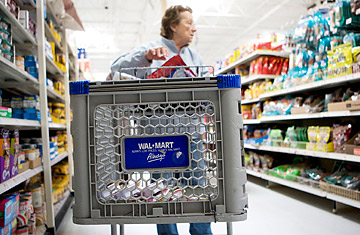
A customer shops for groceries inside a Wal-Mart store in Secaucus, N.J.
Walmart, the world's largest retailer, has seen better days. Yes, profits rose 22%, to $4.63 billion, in the fourth quarter of '09. Even coming out of the Great Recession, many consumers are trading down to shop at the discount superstore. However, for the third straight quarter the store saw negative same-store sales growth; during the last three months of 2009, same-store sales dropped 2%. Overall traffic in Walmart stores was down too. To Walmart executives and investors, this disturbing trend has to be reversed; despite the earnings growth, Walmart's stock fell 1.1% on the day earnings were announced. "We want to see top-line growth," says Deborah Weinswig, a retail analyst at Citigroup. After all, if fewer customers are spending less in Walmart's stores, there's a whiff of dissatisfaction in the aisles.
So what's going on? First off, food deflation in 2009 impacted the entire grocery business. However, a strategic shift from Walmart backfired a bit. In order to implement its "Project Impact" plan, which called for less clutter in the aisles and more space given to other product categories like toys and electronics, the store offered a narrower selection of brands and package sizes in its grocery section, which accounted for some 45% of its store space. This move had a two-pronged effect. Some shoppers, faced with a less robust grocery selection from Walmart, decided to make an extra trip to the neighborhood supermarket, or even dollar stores, to take care of their basic needs. Plus, brands that were spurned by Walmart ran into the arms of its competitors, who were willing to compete aggressively with the retailer on price. "Suppliers don't care about going to war with Walmart because they've been stiffed by its new procurement practices," says retail consultant Burt Flickinger III, managing director of Strategic Resources Group, "and they know they'll be treated fairly at the other stores."
For example, Flickinger's research shows that at a group of WinCo Foods stores in California, the Western grocery chain carried 34 different sizes of detergent brands like Sun, Arm & Hammer, Surf and Gain. Neighboring Walmarts only carried 10 of these sizes. Further, of the 10 brand packages both stores sold, WinCo was cheaper on five of them. Two carried the same price, and Walmart offered better prices on three of the detergent packages. Of the 32 different sizes of Kellogg's cereal brands offered by WinCo, Walmart carried just seven. Of the brands both stores sold, WinCo was cheaper on six of them — two different sizes of Raisin Bran, two different sizes of Frosted Mini-Wheats, one Rice Krispies box and one Cocoa Krispies box. At WinCo, a huge sign trumpeted that a 42-ounce box of Quaker Oatmeal cost $2.48. A similar sign stood at Walmart — Quaker Oatmeal, 42-ounces, $3.12.
Of course, Walmart won't get pounded on price for long. "The time has finally arrived!" Weinswig wrote in a research note. "WMT [Walmart's stock symbol] is lacing up the gloves in the fight to win the modern day price war in food retail in 2010." Weinswig found that a 2-liter bottle of Coca-Cola, which recently cost the consumer $1.58 at a New York City-area Walmart, was now selling at the same store for 98 cents. "You're not going to ignore that," says Weinswig. "That's 'wow' pricing, and you'll think twice about going somewhere else.'"
The company will also return some 300 discontinued items to the shelves, giving the shopper more choice as well. With this aggressive strategy, and upgrades to the shopping experience provided by Project Impact, Weinswig believes Walmart is positioned for a big year: on March 14, she upgraded the stock from hold to buy, and set a price target of $65 per share (after the close of business on March 17, Walmart was trading at $55.92 per share). The company's plan also indicates that a significant swath of American consumers are still hunting for value in the economic rebound, and many of those who "traded down" during the worst of the recession are "staying down." Walmart wants to keep them there. "Over the last few years, we haven't really seen a Walmart initiative that screams 'Price! Price! Price!' says Weinswig. "We're seeing that here." Although the worst of the recession is long over, the American consumer can still use such good news.
